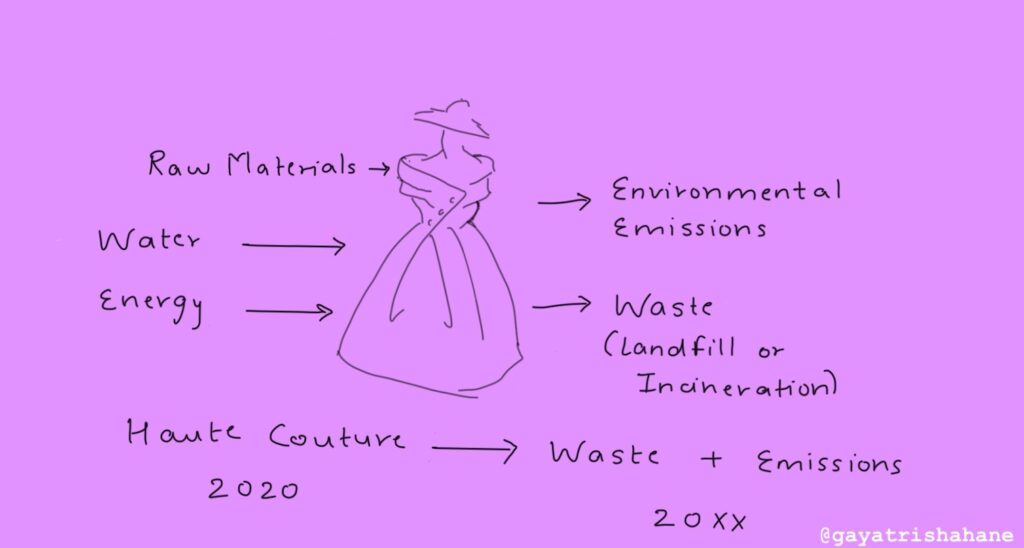“Fashion is the armor to survive the reality of everyday life.” – Bill Cunningham
Our want for fashion arises out of our conditioning that fashion is tied to something we want in life. We want to express our inner artist or to gain corporate acceptance. In this quest of expressing oneself and/or seeking validation, fashion (apparel plus foot ware) contributes over 8 % (3,990 million metric tons CO2eq) of all greenhouse gases.

If we continue business-as-usual, by 2050, more than 25 % of the entire global carbon budget will go to this one industry. In this trillion-dollar industry where the words “sustainable fashion” are thrown around casually or intentionally used for marketing, what is the truth about sustainability in fashion?
What is Sustainable Fashion?
There is no single definition entailing all aspects of sustainable fashion which encourage vital actions from the industry.

If “fashion” is changing every season, how can it be sustained?
One educated definition comes from Kate Fletcher, Research Professor of Sustainability, Design, Fashion at University of the Arts London, who defines Sustainable Fashion as “a movement and process of fostering change to fashion products and the fashion system towards greater ecological integrity and social justice”.
While it is also important to discuss the social hot spots of the industry (occupational health and safety, working hours, labor and women rights), this article mainly addresses the ecological part of sustainability in the whole system of fashion.
Life Cycle Assessment:
The typical Life Cycle Stages of the apparel system are fiber production, yarn preparation, dyeing and finishing, assembly, distribution and end of life.
The 3 main drivers of the fashion industry’s global pollution impacts (in order of their stage, not impact) are:
- fiber production (extraction and processing of fibers)
- yarn preparation (spinning of yarn)
- dyeing and finishing (bleaching and dyeing as well as fabric finishing)
It is interesting that distribution is a not major contributor to global pollution. So in this context, anyone claiming that their distribution is sustainable is merely adding a drop in the ocean.

Energy and Emissions
Dyeing and finishing have the highest impact on climate change and resource depletion. The wet processes used in dyeing require a great amount of heated water.
Fabric and yarn preparation require mostly electricity and almost no additional heat, thus these stages have a lower climate change impact than dyeing.
The high energy and emissions impact in these three stages is due to the energy intensive processing and high dependency on fossil fuels. The largest apparel manufacturing countries like China, India and Bangladesh are heavily coal based energy mixes.
Water
Hazardous chemicals are used for treatments like scouring, bleaching and neutralizing. Moreover, water polluted with these chemicals is returned back to the ecosystem.
Furthermore, fiber production has the highest impact on freshwater withdrawal and ecosystem quality due to conventional cotton cultivation. On the contrary, production of synthetic fiber – the most common textile material, consumes only about half as much as conventional cotton.
20% of the global industrial water pollution is caused by textile dyeing and finishing.
A way forward…
Renewable Energy Powered Systems
To propel the value chain towards a low-carbon future, powering the industry by renewable energy is a low hanging fruit. Hard coal and natural gas show a share of 60 – 70% of the climate change impacts in the dyeing and finishing stage (depends on energy mixes at different locations).
Regenerative Practices
The lifecycle of a cotton shirt begins when seeds of the cotton crop are planted. Regenerative agricultural practices for fiber crops are the foundation of sustainable fashion. Ensuring best practices since the inception of the shirt will make it truly sustainable.
Even though synthetic fiber clothes utilize less water and energy than their cotton counterparts, they are largely oil-based, contribute to marine pollution and are practically non-biodegradable. Recycling synthetic fibers, is a step ahead in the fashion industry.
Conclusion: Conscious Choice
To address the “climate conscious” segment of consumers, companies like Inditex (Zara’s parent company) and Gucci are setting climate goals.
Perhaps I am being too cynical, but can a “fast” fashion brand like Zara and a leather promoting Gucci ever be truly sustainable?
And, are the labels such as “slow” and “sustainable” fashion inherently an oxymoron?
Fashion might as well be the protecting armor against the reality of everyday life, but it is more important to protect us (Us not the Earth!) against climate change.
How do we shop less in a world begging us to buy more?
Have we stripped ourselves of Conscious Choice?

Best article